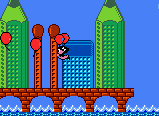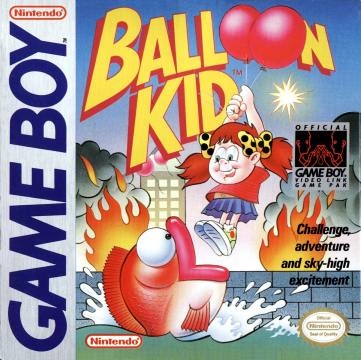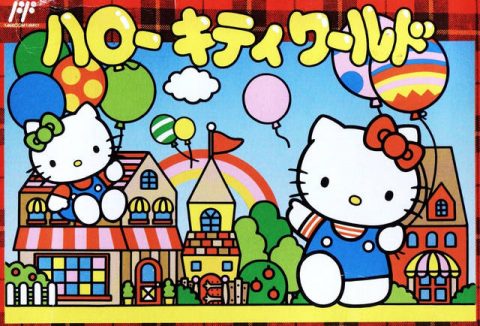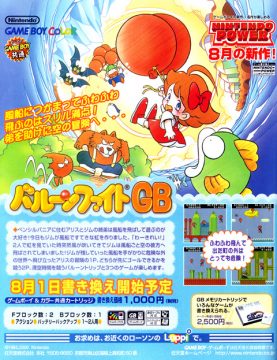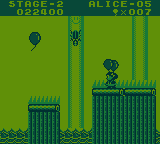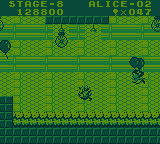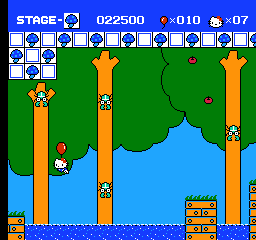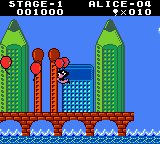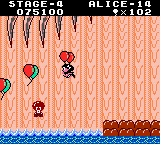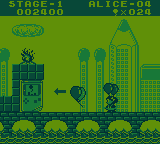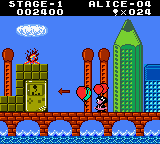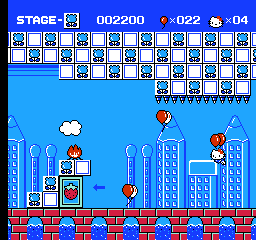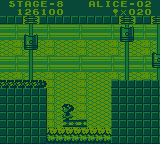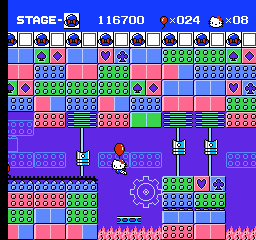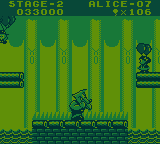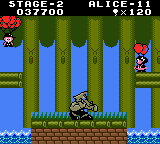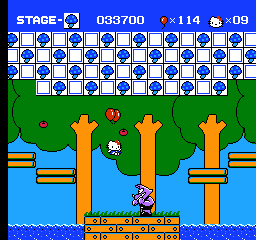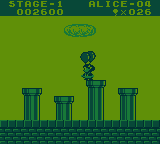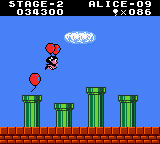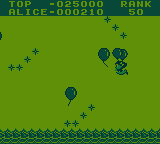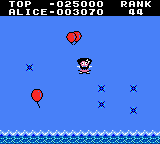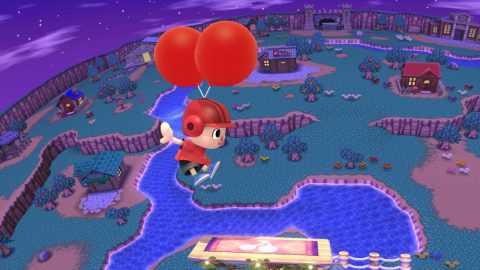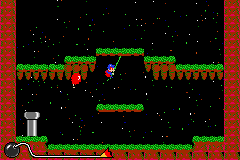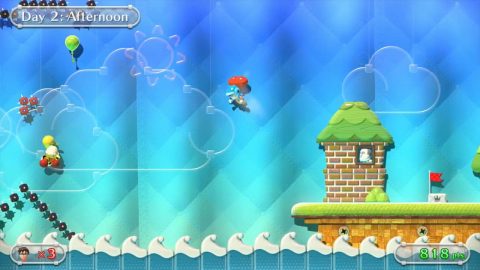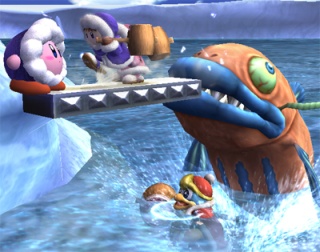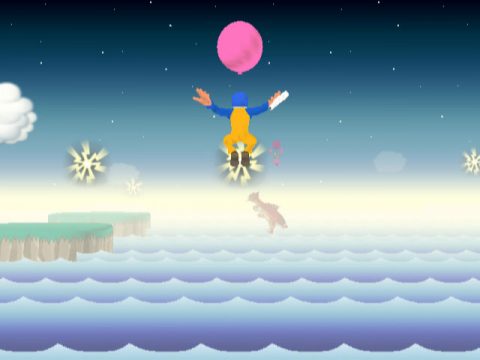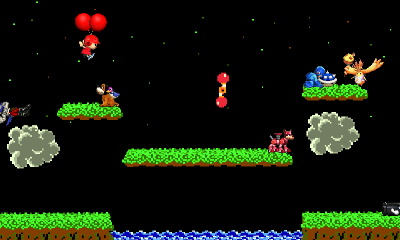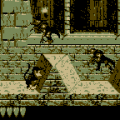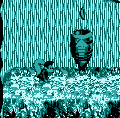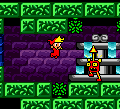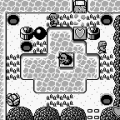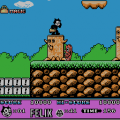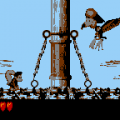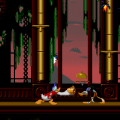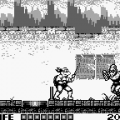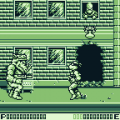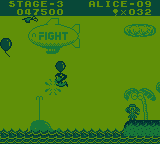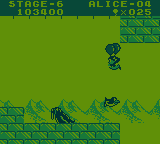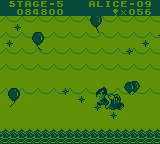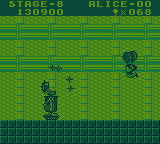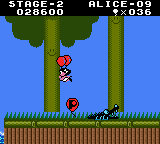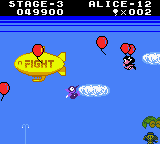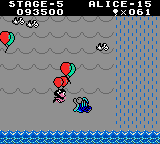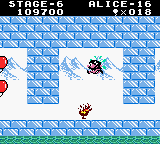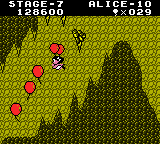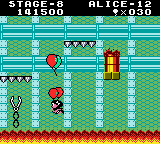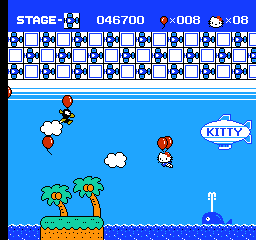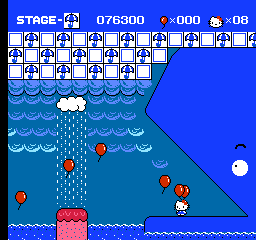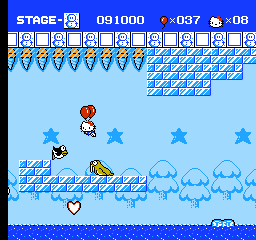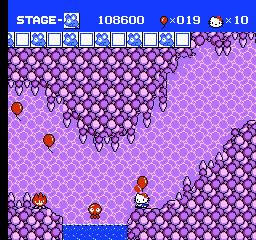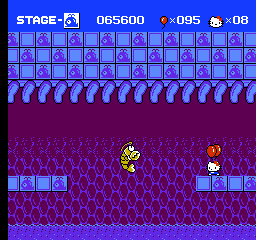- Balloon Fight
- Balloon Kid
A simple port of Balloon Fight would’ve sufficed for Nintendo’s dot matrix portable. Its arcadey roots serves well for on-the-go action, just like the Game & Watch version. The Balloon Trip is also available, but the main mode on Game Boy is a much more full-fledged adventure; a childish one at that, but with a lot more plot than “Pop other baddies’ balloons and don’t die”.
Balloon Kid stars a young girl named Alice who takes to the skies to save her little brother Jim. Both siblings lived in the quaint town of Pencilvania and have a fondness for balloons. Jim decided to tie all of his rainbow-colored balloons to bring color to the sky (It was made for the original monochrome brick Game Boy, after all). However, in a cartoonish folly, all of those balloons lifted Jim too high and he got snatched away in a strong gust and flew to the heavens, leaving his big sister to chase after him. Only a colorful balloon trail left by Jim leads Alice to follow and find him.
The gameplay is an expanded take on the Balloon Trip mode from the NES. The automatic right-to-left scrolling is still rare in the platforming genre, but the first levels take it slow, giving you time to adjust to the physics and controls. The A button does the usual airlift, but the B button makes Alice release her balloons and drop to the ground. Losing your only means of flight might fly in the face of the series’ central element, but there are times where Alice needs to fit through narrow corridors to proceed or nab a power up. On foot, Alice can leap high on her own, but solid footing doesn’t stick around forever. Taking a cue from the Balloon Bird enemies, Alice can blow up a fresh pair of balloons by tapping Down on the D-pad repeatedly. This trick can also replenish any popped balloons in a relative jiffy, but as the scrolling speed amps up in later stages, touchdowns for inflations grow thinner. While balloon collecting is not essential it adds to your score, which racks up extra lives. Collecting enough in a row doubles the balloon count per pickup, along with launching a flashing invincibility powerup balloon to nab. With a link cable, Alice can partner up with her friend/rival Samm, allowing two players to try and beat each other’s score.
Alice must travel through eight levels to find her lost baby brother. Flights soar over her sharp graphite-infused town through a forest, beaches, inside a whale’s belly, an ice-covered landscape, a perilous cave littered with pointy stalagtites and stalagmites, and a factory. The giant fish still lurks in the seas to gobble you up, but the bird-like Balloon Fighters are few in number throughout the game. Instead, several other foes take head as obstacles to avoid, such as walking flames, spiders, penguins, and crocodiles. Sparks also return, alongside instant fry fire hazards. Giant Game Boys appear in many stages to send you into the bonus game from the NES, albeit in a crampier form without the horizontal wraparound shortcut. Every other stage ends with a cartoonish boss blocking the path, who must be defeated with three bops on the head.
Balloon Kid is a rather breezy experience. Much of its design and theme is skewed for a young demographic, which makes the bump in difficulty in the last quarter daunting for its intended audience. The amount of lives easily racked up in the early levels serves well as a bumper when the game speed up and requires tightening precision. Most of the deaths will be in the final stretch of the game, with danger bouncing everywhere and tunnels zigzagging to reach a spark-spewing tin robot. Despite the ratcheting difficulty curve, the length of a decent playthough tops around half an hour. For a game early in the Game Boy’s life cycle, this wasn’t too terrible.
Balloon Kid was developed in Japan, yet never saw release there in its original form. Developer Pax Softnica would later port the game to the Famicom in 1992 and use the license of Hello Kitty and her pals. Hello Kitty World follows the exact same layouts of its portable predecessor, only with the graphics reskinned in pastel hues with plenty of colorful blocks adorning the landscape. Alice, Samm, and Jim were replaced with Hello Kitty and her twin sister Mimmy, who have to rescue Tippy Bear. The enemies were also Sanrio-ized to match, and the Game Boy minigame icons changed to strawberry cards. While the move to the home console makes for a plus in screen size, the level layouts were not changed, leading to a large vertical chunk of the screen being blocked off at all times.
Japan wouldn’t see the original version of Balloon Kid until 2000, when the game was colorized and mildly expanded for a release under the Nintendo Power RAM system. This program sold rewritable carts for Super Famicom and Game Boy that could store up to 7 titles apiece and could be written at stores with a catalog of games to choose from at stores with the hardware and data. This new colored edition of the game, named Balloon Fight GB, was also written onto many of the in-store cartridges for the service. Aside from the splash of vibrant color, the game also added a simple map and a save system, so you could easily pick up where you left off and return to previous stages.
Balloon Fight GB also worked with the Super Game Boy, where it had not just one unique frame but also a hidden extra, selectable with a simple code; a far cry from the paltry pickings of the older Balloon Kid, the only Nintendo developed Game Boy title that didn’t have a built-in chosen palette. Sadly, only Japan has the color release on the 3DS’ Virtual Console while the rest of the world is left with the black & white one, but at least the latter is sold for much cheaper on the eShop. Naturally, both versions lose their two-player modes.
Screenshot Comparisons
Cameos
After the series had fallen off the map for over a decade, appearances related to Balloon Kid began exploding after the turn of the 21st century. The Balloon Fighter was a potential candidate for becoming a Smash contender as the retro brawler in Super Smash Bros. Melee, but that slot was given to the Ice Climber duo. As consolation, the fighter was a trophy, the flipper the pinball bumper replacement for the game, and the Balloon Trip music became the B-side track for Ice Climber’s stage. While the fighter himself would never be seen in his full glory in the fighting series, the giant fish popped up as a dangerous stage hazard in Brawl‘s Icicle Mountain level. Super Smash Bros. for 3DS has a recreation of the NES levels of Balloon Fight as a selectable stage, complete with 2 different regular layouts, sparks, flippers, the fish, walk-off teleporting, and the tourney-safe Omega mode. The fourth game also snuck in a nod to the franchise with Animal Crossing‘s Villager fighter donning a helmet and two balloons to float as an Up-Special, complete with the old sound effects, movement, and falling animations recreated. The later titles in the Smash series also included remixes and medleys, focusing most of the arrangements on “Balloon Trip”.
WarioWare served as a nice venture for cameos, thanks to the retro-centric 9-Volt microgame sets. Nearly every release had a visit from the fighter with brief seconds of the usual gameplay, like popping or collecting balloons, or dodging obstacles. The biggest deviations are found in Twisted!‘s tilting mechanic to lead a balloon to a stranded Balloon Fighter and Smooth Move‘s 3D third-person viewpoint of the standard Balloon Trip mode, where the Wii remote must be flapped up and down to fly – even an endless variant of this microgame is unlockable. The Balloon Fighter also serves are the icon for playing created music in D.I.Y. and is the microgame’s mascot in Game & Wario‘s Gamer portion.
Plenty of other tiny tidbits from the series arrived in various Nintendo products. Sprites cropped up in many puzzle titles such as Tetris DS, Picross DS, and Art Style: PiCTOBiTS. Game Boy Camera has Balloon Kid‘s BGM reused for certain menus, such as “Hot Spot”. NES Remix and its 3DS port would add in an entire roster of challenges in Balloon Fight, along with a few simple remixed stages with the screen zooming in or out, or all the enemy fighters as mirrored copies of the player. The biggest appearance yet from the series would arrive as an attraction in 2012’s Nintendo Land. “Balloon Trip Breeze” is a graphically enhanced take on Balloon Trip mode, but you can only control the flight of your floating Mii by moving gusts of wind over the Gamepad with the stylus. Iwata himself tweaked the physics of this minigame to match the NES original.
After disappearing from the minds throughout the 90s, Balloon Fight‘s resurgence brought a new audience a taste of the simple but addicting arcade challenge. Joust might’ve made a more significant historical mark on the annals of classic gaming, but the Nintendo’s take of its gameplay can be seen as a remarkable improvement, along with being an example of what a programmer’s knowledge and skills can bring, and that’s not just a lot of hot air.
